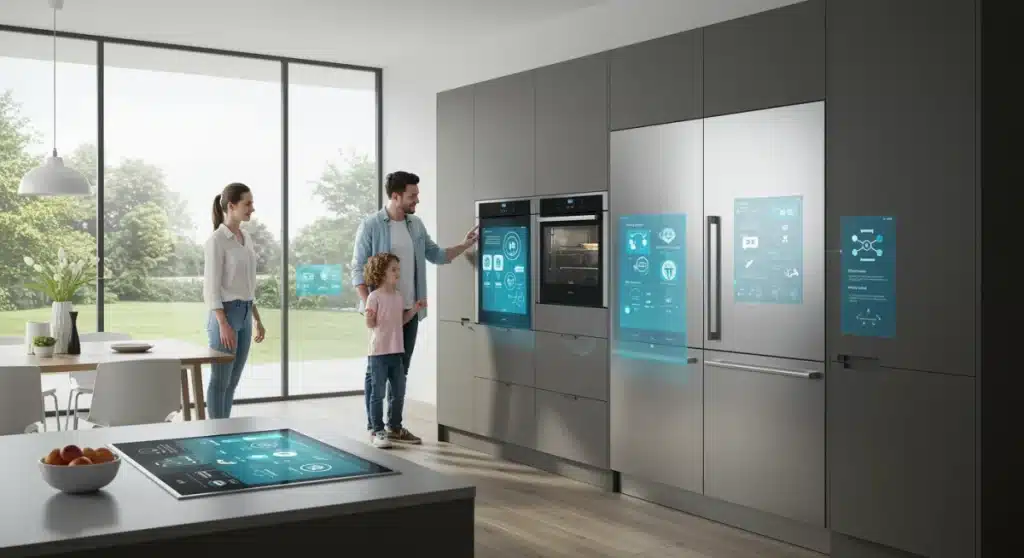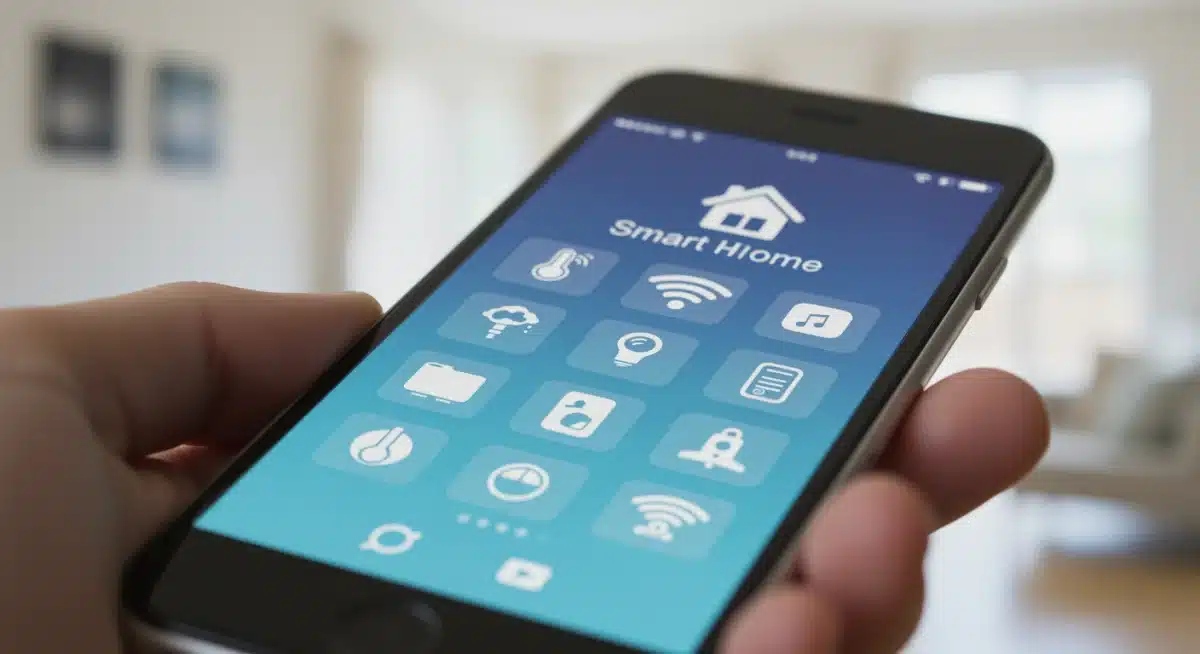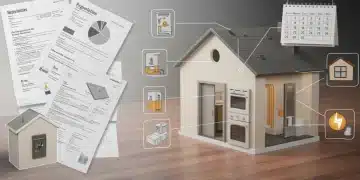Integrating Smart Appliances: US Households 2025 Guide

Integrating smart appliances into US households by 2025 offers practical solutions for enhanced efficiency, security, and convenience, streamlining daily routines through interconnected devices and intelligent systems.
As of late 2024, the landscape of home technology continues its rapid evolution, making integrating smart appliances a practical reality for US households in 2025. This guide provides a step-by-step approach to seamlessly connect your home, enhancing daily life with cutting-edge solutions.
Understanding the Smart Home Ecosystem
The smart home ecosystem refers to the interconnected network of devices, platforms, and services that automate and optimize household functions. For US households in 2025, this ecosystem is becoming increasingly sophisticated, offering unparalleled convenience and efficiency.
At its core, a smart home relies on various communication protocols to allow devices to ‘talk’ to each other. Understanding these foundational elements is crucial before you begin integrating smart appliances into your living space.
Key Communication Protocols
- Wi-Fi: The most common protocol, offering broad compatibility and high bandwidth for many smart devices.
- Zigbee: A low-power, mesh network protocol ideal for smaller data packets and extending network range, often used for lighting and sensors.
- Z-Wave: Similar to Zigbee, but operates on a different radio frequency, offering robust security and reliability for home automation.
- Bluetooth: Best for direct, short-range connections, often found in personal devices and some smart locks.
Choosing devices that support compatible protocols ensures smoother integration. Many modern smart hubs are designed to bridge these different technologies, creating a unified control system for your entire home. This convergence is a significant trend for 2025, simplifying setup and management for the average user.
Planning Your Smart Appliance Integration Strategy
Before purchasing any smart appliances, a well-thought-out plan is essential. For US households aiming for seamless integration in 2025, this involves assessing current needs, setting a budget, and identifying key areas for automation. Haphazard purchases can lead to compatibility issues and a fragmented smart home experience.
Consider what aspects of your daily life you want to improve. Is it energy efficiency, security, convenience, or a combination? Your priorities will dictate the type of smart appliances and systems you should invest in.
Assessing Your Home’s Readiness
- Network Infrastructure: Ensure you have a robust and stable Wi-Fi network that can handle multiple connected devices. Upgrading your router might be a necessary first step.
- Power Outlets: Verify that you have enough accessible power outlets for new appliances and smart hubs.
- Device Compatibility: Research which brands and devices work well together. Many manufacturers now adhere to open standards or offer extensive compatibility lists.
Starting with a clear vision prevents common integration pitfalls. Think about scalability as well; your smart home should be able to grow with your needs and adapt to future technologies. This forward-thinking approach is vital for any US household looking to effectively integrate smart appliances.
Selecting the Right Smart Appliances for Your Needs
The market for smart appliances is vast and continually expanding. For US households in 2025, choosing the right devices means balancing functionality, compatibility, and cost. Focus on appliances that provide genuine value and align with your integration strategy.
From smart refrigerators that track inventory to intelligent thermostats that learn your preferences, the options are diverse. Prioritize appliances that address your most pressing needs or offer the greatest potential for daily improvements.
Top Categories for Smart Appliances
- Kitchen: Smart refrigerators, ovens, dishwashers, and coffee makers offer convenience and efficiency. Many can be controlled remotely or automate tasks based on schedules.
- Climate Control: Smart thermostats like Nest or Ecobee learn your habits, optimize energy usage, and can be adjusted from anywhere.
- Lighting: Smart bulbs and switches allow for customized lighting scenes, remote control, and energy savings.
- Security: Smart door locks, video doorbells, and security cameras enhance home safety and provide peace of mind.
- Cleaning: Robotic vacuums and mops can be scheduled and controlled via apps, simplifying household chores.
When selecting, always check product reviews and look for devices from reputable manufacturers known for their reliability and customer support. The goal is to build a cohesive system where each appliance contributes to a smarter, more efficient home environment.
Setting Up Your Smart Home Hub and Network
A central smart home hub is often the brain of your integrated system. For US households aiming for seamless smart appliance integration in 2025, a robust hub ensures all devices can communicate effectively, regardless of their individual protocols. This critical component acts as the bridge between various smart devices and your control interfaces.
Without a hub, managing multiple smart devices can become cumbersome, requiring separate apps for each. A good hub streamlines control, automates routines, and enhances overall system stability.
Steps for Hub and Network Setup
- Choose Your Hub: Popular options include Amazon Echo, Google Home, Apple HomeKit, and dedicated hubs like SmartThings. Consider which ecosystems your chosen appliances support.
- Connect to Power and Internet: Place your hub in a central location, connect it to power, and ensure it has a stable internet connection, preferably via Ethernet for reliability.
- Download the App: Install the hub’s companion app on your smartphone or tablet. This will be your primary interface for configuration and daily control.
- Configure Wi-Fi: Ensure your home Wi-Fi network is optimized for smart devices. This might involve setting up a dedicated 2.4 GHz network for some devices and ensuring adequate signal strength throughout your home.
Proper hub and network setup forms the backbone of a successful smart home. Take the time to understand the hub’s capabilities and how it interacts with your network to avoid connectivity issues down the line. A well-configured hub is the key to unlocking the full potential of integrating smart appliances.

Integrating Appliances and Creating Automation Routines
Once your hub and network are established, the next step for US households in 2025 is to begin integrating smart appliances and creating intelligent automation routines. This is where the true power of a smart home becomes apparent, transforming individual devices into a cohesive, automated system that anticipates your needs.
The process typically involves adding each smart appliance to your hub’s ecosystem and then defining rules or ‘routines’ that dictate how they interact. This can range from simple scheduled actions to complex, multi-device scenarios triggered by specific events.
Effective Automation Strategies
- Device Pairing: Follow the manufacturer’s instructions to pair each smart appliance with your central hub. This often involves a discovery mode on the hub and a pairing sequence on the device.
- Scene Creation: Group multiple actions into a single command. For example, a ‘Good Morning’ scene could turn on lights, adjust the thermostat, and start the coffee maker.
- Conditional Routines: Set up automations based on specific conditions, such as turning off lights when motion is not detected, or adjusting the AC when the outdoor temperature hits a certain level.
- Voice Control Integration: Connect your hub to voice assistants like Alexa or Google Assistant for hands-free control of your appliances.
Experiment with different routines to find what works best for your lifestyle. The beauty of integrating smart appliances lies in their flexibility and ability to adapt to your evolving needs, making daily tasks simpler and more efficient. Regularly review and refine your automations to ensure they continue to serve their purpose effectively.
Security, Privacy, and Maintenance Considerations
As US households increasingly adopt smart appliances in 2025, addressing security, privacy, and ongoing maintenance becomes paramount. The benefits of convenience and efficiency must be balanced with robust protection against potential vulnerabilities and ensuring the longevity of your smart home system.
Every connected device represents a potential entry point for cyber threats. Therefore, proactive measures are essential to safeguard your personal data and maintain the integrity of your smart home network. Regular maintenance also ensures optimal performance and extends the lifespan of your investments.
Ensuring a Secure Smart Home
- Strong Passwords: Use unique, complex passwords for all smart device accounts and your Wi-Fi network. Avoid default passwords.
- Two-Factor Authentication (2FA): Enable 2FA wherever possible to add an extra layer of security to your accounts.
- Regular Software Updates: Keep all smart appliance firmware and hub software updated to patch security vulnerabilities and improve functionality.
- Network Segmentation: Consider setting up a separate guest Wi-Fi network or a dedicated IoT network to isolate smart devices from your main personal network.
- Privacy Settings: Review the privacy settings for each device and app, limiting data collection and sharing where appropriate.
Beyond security, regular maintenance, such as cleaning sensors, checking battery levels, and ensuring stable network connectivity, will keep your smart appliances running smoothly. Being vigilant about these aspects is crucial for a secure, private, and reliable smart home experience.
The Future of Smart Home Integration in the US
Looking ahead, the trajectory of integrating smart appliances for US households in 2025 and beyond points towards even greater intelligence, interoperability, and energy efficiency. Emerging trends suggest a future where homes are not just smart, but truly intuitive, anticipating needs and making decisions autonomously to optimize comfort, security, and sustainability.
The focus is shifting from mere remote control to predictive analytics and proactive management, driven by advancements in AI and machine learning. This evolution promises to redefine how we interact with our living spaces, making smart homes an indispensable part of modern life.
Upcoming Smart Home Innovations
- AI-Powered Personalization: Smart homes will increasingly learn individual habits and preferences, offering hyper-personalized experiences without explicit programming.
- Enhanced Interoperability: New industry standards and protocols will further break down silos between different brands and ecosystems, simplifying integration even more.
- Sustainable Living: Smart appliances will play a larger role in energy management, optimizing consumption based on real-time grid data and personal usage patterns.
- Ambient Computing: Technology will become even more seamlessly integrated into the environment, responding to natural language and gestures, almost fading into the background.
- Advanced Health Monitoring: Smart devices will extend into health and wellness, monitoring vital signs, sleep patterns, and assisting with elder care.
These developments underscore a future where integrating smart appliances is not just about convenience, but about creating dynamic, responsive, and supportive living environments. US households in 2025 are at the cusp of this transformative era, with endless possibilities for innovation and improved quality of life.
| Key Aspect | Brief Description |
|---|---|
| Ecosystem Planning | Crucial for seamless integration, aligning devices with home needs and communication protocols. |
| Hub & Network Setup | Essential for central control and reliable device communication within the smart home. |
| Automation Routines | Transforms individual devices into an intelligent, responsive system through predefined actions. |
| Security & Privacy | Key considerations for safeguarding data and ensuring protection against cyber threats. |
Frequently Asked Questions About Smart Appliance Integration
The primary benefit is enhanced convenience and efficiency. Integrated smart appliances automate daily tasks, optimize resource usage, and provide remote control, simplifying household management and improving overall quality of life for US households.
Not always. Compatibility depends on shared communication protocols and ecosystem support. Choosing a central hub and devices that adhere to common standards like Wi-Fi, Zigbee, or Z-Wave significantly improves seamless integration.
For beginners, a smart thermostat, smart lighting, and a voice assistant are excellent starting points. These devices offer immediate benefits in energy savings, convenience, and serve as a foundation for expanding your smart home system.
Ensure security by using strong, unique passwords, enabling two-factor authentication, regularly updating device firmware, and considering a separate Wi-Fi network for IoT devices. These steps protect against unauthorized access and data breaches.
A smart home hub acts as the central brain, allowing different smart appliances to communicate and operate cohesively. It unifies control, simplifies automation, and bridges various communication protocols, optimizing the entire smart home ecosystem.
Looking Ahead
The rapid advancements in smart home technology signify a pivotal shift in how US households interact with their living spaces. As of late 2024, the trend points towards increased AI integration and enhanced interoperability, promising a future where homes are not just connected but truly intelligent. Consumers should anticipate more personalized and energy-efficient solutions, driving further adoption. The ongoing evolution will prioritize user-friendliness and robust security, making smart appliance integration an even more accessible and indispensable aspect of modern life.





